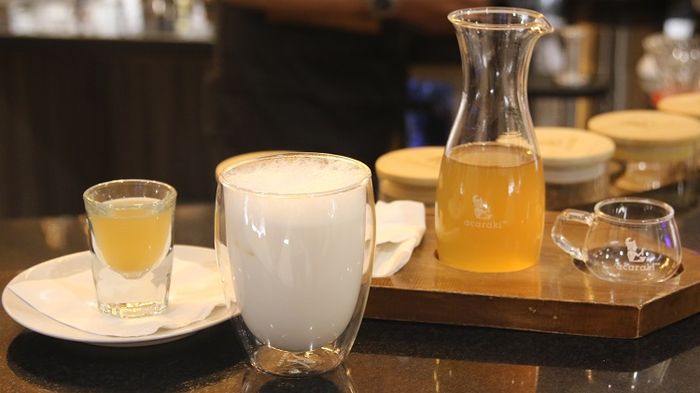
Kitchenesia had the pleasure to interview Jonny Yuwono, founder of Acaraki Jamu Cafe. Learn how his motives in running the jamu cafe is beyond profit, and latent problems of Jamu industry.
Kitchenesia.com - According to Jakarta-based entrepreneur Jony Yuwono, Acaraki is inspired by his bewilderment of Jamu: priceless but ignored. For him, it is unbelievable that as two types of beverages, coffee and jamu, share similar bitterness but have contrasting fate.
The first is probably the most popular drink in the world, with billions cups sold per day in the world. The latter, on the other hand, is much less popular than the first, to the point people might have consumed it years ago.
In less than a year, Acaraki has been developed into two branches: in Kemang and Kota Tua. People might not appreciate jamu as great as coffee. But with two branches in a year (something that shoud be bragged about), he believes that there must be a way to raise people's interest in jamu.
The coffee scene in big cities like Jakarta has been on the upswing in the last few years, and the trend is most likely going on years ahead. Considering this fact, why don't you run coffee shop instead?
It started when my friends and I had a discussion about jamu. All of them have tried it before, but they don't have a "good memory" about jamu. From this, my conclusion is that jamu has a great brand awareness among locals. But the challenge is, how to change the perception of jamu from "bitter and old-fashioned drink" to "hip and daily drink".
It took 4 years for me to find a way out of this problem. After conducting surverys form one region to another, from one jamu maker to others, it turns out that almost all of jamu makers are still processing it in traditional ways, which is digodok (i.e similar to boiling).

In the past, traditional coffe makers also make coffee by boiling its beans. But now, coffee is served with machine, and it is combined with milk, creamer, even whipped cream. Why can't it applicable to jamu? Jamu is still jamu as long as the main spices (e.g cloves or turmeric) are included.
If jamu is served this way, I believe people will make jamu as their morning drink, replacing coffee (laugh).
If jamu is served with machines and modern condiments like creamer, do you think jamu has lost its traditional status?
I attended jamu exhibition event in 2015, and there were 75 traditional jamu makers around Indonesian participated in this event. Every participant exhibited their beras kencur (popular jamu drink with rice and sand ginger).
The most surprising thing is that each beras kencur doesn't taste the same. One's beras kencur uses cloves, another uses cinnamon. Some of them use blender and the others use pestle to grind sand ginger. What they share in common are rice and sand ginger. Are those still considered as beras kencur? Of course.
Jamu is complicated. Until now, there isn't negotiated recipe for beras kencur, or jamu in general. Jamu is part of family tradition. That's why, different family means different recipes.

In Acaraki, we show jamu through our open kitchen. If you order beras kencur, then what you have is a jamu drink combining rice and sand ginger. What you order is what you get. If the customers ask for more sugar, then we do it in front of them. Acaraki guarantees openness.
As you said earlier, there is a latent danger waiting to happen in jamu industry.
The "coffee boom" phenomenon affects herbs farmers significantly. Many farmers and land owners now prefer to grow coffee as its demand is booming. Land becomes scarce as population grows rapidly. If this continues to happen, main ingredients of jamu like sand ginger or turmeric will exinct. Otherwise, the worst case is Indonesia will import some spices from overseas that used to grow in our country.
Almost all of jamu gendong (i.e female jamu sellers-cum-makers) sellers are reaching their old ages. If there's no one who inherit their jamu recipes, then jamu spices and jamu recipe will be gone.

Therefore, the most effective way to preserve jamu is treating it as lifestyle drink, just like coffee. In Acaraki, we are commited to use spices directly from the farmers. We use rice from farmers in Lampung, sand gingers from Wonogiri, Central Java. We are not overtaking jamu gendong's job. Instead, we cooperate with them to preserve recipes and herbs of jamu.
You are listed on Board of Directors of PT. Sinde Budi Sentosa, one of leading jamu corporate in the country. What are your reasons to begin a jamu cafe while you are actually a jamu tycoon? I don't think it's for profit.
Acaraki is like an act of rebellion against foreign cultures. It's sad seeing foreign cultures are considered cool and youtful, while jamu is perceived as the otherwise: old-fashioned and dirty. Acaraki vision is to change it all, by serving jamu in modern way.






